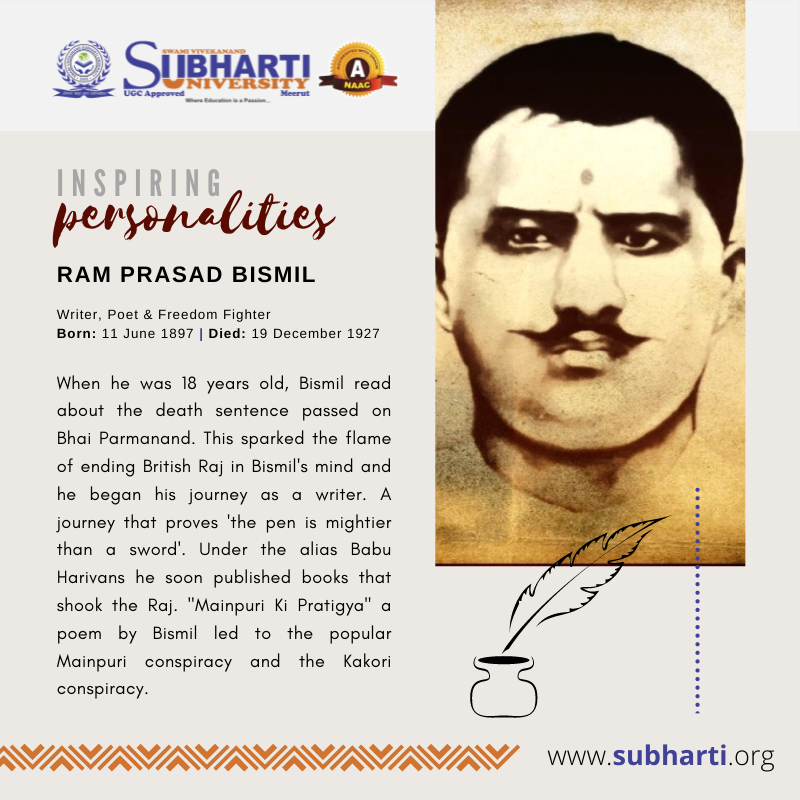Born: 11th June 1897
Died: 19th December 1927
Shri Ram Prasad Bismil was born on 11th June 1897 into a brahmin family in Shahjahanpur, North-Western Provinces of British India. Despite his father’s disapproval he was admitted to an English-language school, and also joined the Arya Samaj in Shahjahanpur. He also learned Hindi (from his father) & Urdu (from a moulvi).

When he was 18 years old, Bismil read about the death sentence passed on Bhai Parmanand, who was a scholar and also the companion of Har Dayal. At that time he was attending the Arya Samaj Temple at Shahjahanpur regularly, where Swami Somdev (a friend of Paramanand) was staying. Angered by the sentence, Bismil composed a Hindi poem “Mera Janm”, which he showed to Somdev. The poem illustrated a commitment to remove British control from India. In the following year, Bismil left school and along with some friends traveled to Lucknow. They organized a group of youths and decided to publish a Hindi book with the consent of Somdev titled “America Ki Swatantrata Ka Itihas, published under the authorship of the fictitious Babu Harivans”. As soon as the book was published, the Uttar Pradesh government banned its circulation within the state. In January 1918, Bismil published a pamphlet titled “Deshvasiyon Ke Nam Sandesh”, which he distributed along with his other poem “Mainpuri Ki Pratigya”. In 1918, looting was undertaken on three occasions to collect funds for the party. Police searched for the robbers in and around Mainpuri while they were selling books banned by the Government. When police found them, Bismil escaped with the books unsold. When he was planning another robbery, police arrived there and started firing from both sides. Bismil then jumped into the river (Yamuna) and swam underwater. His associates and police thought that he died in the encounter. His associates were arrested and were kept in Agra fort. Bismil then fled to Delhi and lived there (hiding). This incident is known as the “Mainpuri Conspiracy” and a criminal case was filed against all of them. On 1st November 1919, B. S. Chris (The Judiciary Magistrate of Mainpuri) declared the judgment against all accused. Dixit and Bismil were declared absconders. During 1919-1920 Bismil remained unnoticeable, moved around various villages in the U.P. producing several books. Bismil returned to Shahjahanpur in February 1920, when all the prisoners of the Mainpuri conspiracy were released, and there he agreed in front of the official authorities for not taking part in any of the revolutionary activities. In 1921, many people of Shahjahanpur attended the Ahmedabad Congress and Bismil was one of them. In February 1922 some agitating farmers were killed in Chauri Chaura by the police and the police station there was attacked and 22 policemen were burnt alive. In the Gaya session of Indian National Congress 1922, Bismil and his group of youths strongly opposed Gandhi Ji, for declaring an immediate stop to the non-co-operation movement without consulting any executive committee member of the Congress, and that without knowing the facts behind the incident. In January 1923, under the joint leadership of Moti Lal Nehru and Chittranjan Das, the rich group of parties formed a new Swaraj Party, and under the leadership of Bismil, the youth group formed a revolutionary party.
यदि देश के हित मरना पड़े, मुझको सहस्रों बार भी।
तो भी न मैं इस कष्ट को, निज ध्यान में लाऊं कभी।।
हे ईश! भारतवर्ष में, शत बार मेरा जन्म हो।
कारण सदा ही मृत्यु का, देशोपकारक कर्म हो।।मरते हैं बिस्मिल, रोशन, लाहिड़ी, अशफ़ाक़ अत्याचार से।
होंगे पैदा सैंकड़ों, उनके रुधिर की धार से।।
उनके प्रबल उद्योग से, उद्धार होगा देश का।
तब नाश होगा सर्वदा, दु:ख शोक के लवलेश का।।सब से मेरा नमस्कार कहिए,
तुम्हारा
“बिस्मिल”
In 1925, Bismil executed a conscientious plan for looting the government treasury carried in a train at Kakori, near Lucknow in U.P.
The historical event happened on 9th August 1925 and is known as the Kakori conspiracy. Ahmed Ali, a passenger, who had gotten down from the train to see his wife in the ladies compartment was accidentally shot and killed by Manmath Nath Gupta. After this incident, more than 40 revolutionaries were arrested whereas only 10 people had taken part in the loot. However, some of them were let off. A defense committee was also formed to defend the accused. Finally, the men were found guilty and all the future appeals failed. Even a final appeal for clemency was forwarded to the Privy Council in London on 16 September 1927, but that also failed. After following 18 months of legal process, Bismil, Ashfaqulla Khan, Roshan Singh, and Rajendra Nath Lahiri were sentenced to death. Bismil was hanged on 19th December 1927 at Gorakhpur Jail, Ashfaqulla Khan at the Faizabad Jail, and Roshan Singh at Naini Allahabad Jail. Lahiri had been hanged two days earlier at Gonda Jail. Bismil’s body was taken to the Rapti river for a Hindu cremation, and the place became known as Rajghat.







